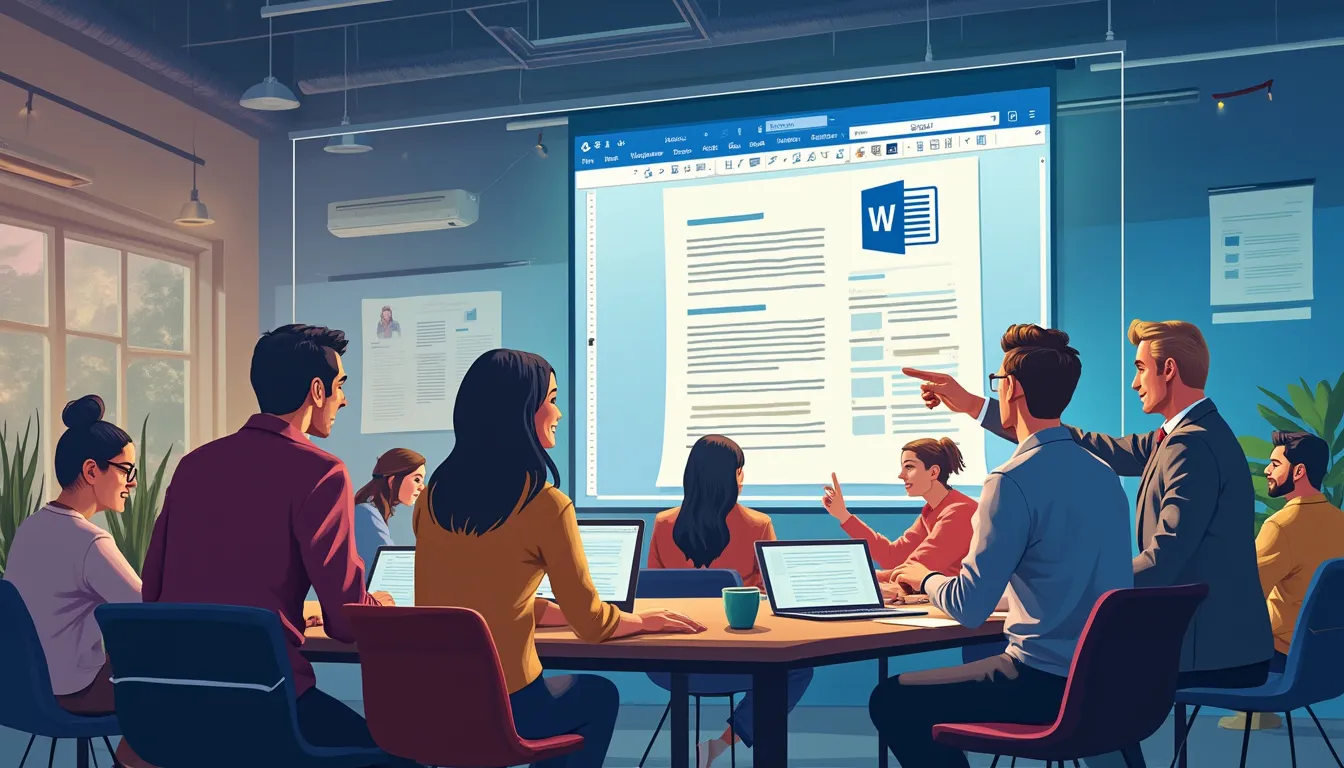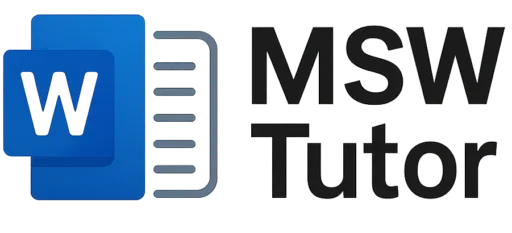In the fast-paced world of document editing, mastering Microsoft Word real-time collaboration is no longer just a nice-to-have—it’s a must! Imagine this: you and your team are working on a critical report, and instead of the chaos of email attachments flying back and forth, you can collaborate seamlessly in real-time. With Microsoft Word’s robust collaboration features, you can enhance productivity and streamline communication like never before.
From creating and sharing documents to utilizing powerful commenting and editing tools, this article dives into the nitty-gritty of maximizing your collaborative efforts. Want to supercharge your teamwork skills in Word? Buckle up, because we’re about to unveil essential tips and tricks for effective Microsoft Word real-time collaboration that will have you and your colleagues working harmoniously in no time! Let’s get started on this collaborative journey!
I. Microsoft Word Real-Time Collaboration
A. Importance of Real-Time Collaboration in Document Editing
In the age of remote work, Microsoft Word real-time collaboration has become essential. Whether you’re crafting a report with your team or collaborating on a thesis with classmates, the ability to edit documents simultaneously can save time and enhance creativity. The essence of teamwork lies in seamless interaction, and Microsoft Word provides the perfect platform to achieve that!
Here are a few ways Microsoft Word real-time collaboration enhances document editing:
1. Efficiency: Multiple individuals can work on a document at the same time, allowing ideas to flow freely.
2. Instant Feedback: Get immediate responses from your collaborators, making the editing process smoother.
3. Unified Changes: Keep all edits in one place, avoiding the chaos of multiple document versions.
B. Overview of Microsoft Word’s Collaboration Features
Microsoft Word real-time collaboration is packed with features designed to make teamwork effortless. Below are key functionalities that make your editing experience a breeze:
- Co-Authoring: Invite others into your document, allowing them to edit alongside you in real-time.
- Inline Comments: Collaborators can leave comments, ensuring constructive feedback occurs right at the relevant section.
- Version History: Easily access previous versions of the document to see what changes have been made or revert if necessary.
- Chat and @Mentions: Communicate directly within the document via the chat feature and tag users with @ to draw their attention to specific sections.
C. Brief Mention of the Article’s Tips and Tricks
To unlock the true potential of Microsoft Word real-time collaboration, this article offers practical tips and tricks. From preparing your document for sharing to optimizing communication with collaborators, you’re covered on all fronts. Get ready to explore how to make your collaboration efforts straightforward and productive!
Don’t forget to check external resources like the official Microsoft 365 support page for further insights and tutorials on Microsoft Word real-time collaboration. Whether you’re a novice or an experienced user, there’s always something new to learn.

Tips for Effective Microsoft Word Real-Time Collaboration
Setting Up for Collaboration
1. Creating and Sharing Documents
To kickstart your journey into Microsoft Word real-time collaboration, you need to create your document and believe me, this is easier than pie! Here’s how:
– Open Microsoft Word: Start by launching the application.
– Select a Template: Choose from an array of templates or start with a blank document.
– Save Your Document: Once created, navigate to File > Save As to save your document in OneDrive or SharePoint. This is crucial for easy sharing and collaboration.
2. Inviting Collaborators through the Sharing Option
Now that your document is ready, it’s time to invite the squad! Here’s how to do it:
– Click on the Share Button: Located at the top right corner.
– Select Who to Share With: Enter email addresses or select from your contacts.
– Set Permissions: Choose whether to allow editing or just viewing. You can manage permissions based on trust levels, which is essential in Microsoft Word real-time collaboration.
– Send Invitation: With one click, your collaborators will receive an email invitation to join the document!
Utilizing the Commenting and Editing Tools
1. How to Use Comments Effectively
Communication is key, and comments are your best friend in Microsoft Word real-time collaboration. Here’s how to make them work for you:
– Add Comments: Highlight the text you want to comment on, then go to the Review tab and click on “New Comment.”
– Be Clear and Concise: Make comments straightforward to avoid confusion. Use bullet points if necessary!
– Tag Collaborators: Use “@” to tag someone directly in your comment. They’ll get a notification, ensuring your feedback isn’t missed!
2. Tracking Changes and Resolving Comments
Keeping track of edits is essential for a clean collaborative process. Here’s how to do it superbly:
– Enable Track Changes: Head to the Review tab and click “Track Changes.” This way, all edits made in the document are highlighted.
– Review Edits: Go through the changes made by collaborators. Accept or reject changes as appropriate.
– Resolve Comments: Once an issue raised in a comment has been addressed, mark it as resolved. Click on the comment, then select “Resolve.” It keeps the document tidy and organized!
Advanced Techniques for Enhancing Collaboration
Leveraging Built-In Features for Productivity
1. Using Version History to Track Changes
Who doesn’t love a good backtrack? With Microsoft Word real-time collaboration, you can track changes and retrieve older versions. Here’s how to tap into this feature:
– Access Version History: Open the document, then go to File > Info > Version History. This will show you a list of edits made over time.
– Restore Previous Versions: If something went wrong, simply select a version to view and restore.
2. Managing Permissions for Different Collaborators
Customized permissions can be a game-changer:
– Edit Permissions: Select collaborators who can edit the document and adjust their levels as needed.
– Restrict Access: For sensitive info, make some sections view-only. This ensures the right eyes see the right stuff.
Best Practices for Successful Team Collaboration
1. Tips for Clear Communication within Word
Even the best tools won’t help if misuse occurs. Follow these tips for stellar communication in Microsoft Word real-time collaboration:
– Use Clear Language: Don’t cloak your messages in jargon. Be straightforward.
– Utilize Tables for Clarity: Organizing information in tables can streamline communication. Here’s an example:
| Task | Assigned To | Deadline |
|---|---|---|
| Draft Outline | John | March 1 |
| Design Graphics | Alice | March 5 |
2. Regular Check-Ins and Feedback Loops for Ongoing Projects
Establishing a routine aids productivity and morale. Here’s how to keep the momentum up:
– Schedule Weekly Check-Ins: Regularly touch base to discuss progress, challenges, and next steps.
– Create Feedback Loops: Encourage open feedback for continuous improvement. Embed a feedback section in the document for collaborative evaluations.
With these strategies, you’re poised to master Microsoft Word real-time collaboration like a pro—ensuring your team is always on the same page! Happy collaborating!

Advanced Techniques for Enhancing Microsoft Word Real-Time Collaboration
A. Leveraging Built-In Features for Productivity
When it comes to Microsoft Word real-time collaboration, the built-in features can truly enhance your teamwork experience. Here are a couple of standout tools you can utilize:
1. Using Version History to Track Changes
Did you know that Microsoft Word allows you to track changes seamlessly? With version history, you can see who made what edits and when. Here’s how to access it:
– Step 1: Open your document in Word Online or the desktop version.
– Step 2: Click on the “File” tab.
– Step 3: Select “Info” and then “Version History.”
– Step 4: Browse through past versions to view edits and restore older drafts.
This feature is invaluable for ensuring that you maintain the direction of your document while still allowing creative input from your collaborators. It’s like time travel, but for your writing!
2. Managing Permissions for Different Collaborators
In a world of ever-expanding teams, managing permissions is key to effective Microsoft Word real-time collaboration. It ensures that only the right people can edit or comment on your document.
Here’s a breakdown:
| Permission Level | Access Type | Best Used When |
|---|---|---|
| Owner | Full editing and sharing rights | Leading a project |
| Can Edit | Editing permissions only | Team members working on a shared document |
| Can Comment | Commenting rights only | Stakeholders giving feedback without altering the document |
| View Only | No editing or commenting | For information-sharing instances |
To set permissions, simply:
– Click on the “Share” button.
– Enter your collaborators’ email addresses.
– Choose the appropriate access level before sending the invitation.
Getting this right is essential for maintaining the integrity of your document while leveraging the power of collaboration.
B. Best Practices for Successful Team Collaboration
Achieving effective Microsoft Word real-time collaboration doesn’t just hinge on tools; it’s also about maintaining a healthy communication culture. Here are some best practices to ensure success:
1. Tips for Clear Communication Within Word
To avoid misunderstandings and chaos in your document, consider these tips:
– Be Specific: When leaving comments, provide context. Instead of saying “this needs work,” try “this section requires more recent data on market trends.”
– Use @ Mentions: Tag your collaborators in comments to get their attention quickly, e.g., “@Sarah can you clarify this point?”
– Organize Comments: Use threaded comments on complex issues. This makes discussions easier to follow and manage.
By fostering clear communication, you’ll find that your Microsoft Word real-time collaboration becomes smoother and more productive.
2. Regular Check-Ins and Feedback Loops for Ongoing Projects
It’s wonderful to collaborate in real time, but ensuring everyone is on the same page is crucial. Incorporating regular check-ins and feedback loops can prevent misalignment and keep the momentum going.
– Schedule Weekly Stand-ups: A quick catch-up every week can be beneficial to discuss progress and blockers.
– Use Comment Summaries: At the end of each collaboration period, summarize comments and decisions made to ensure nothing is missed.
– Establish Deadlines for Feedback: Encourage collaborators to share their thoughts within a certain timeframe to keep things moving.
Implementing these practices ensures that everyone feels valued and informed during the document creation process.
Remember, mastering Microsoft Word real-time collaboration is about using the right features and establishing a productive team environment. With these advanced techniques and best practices at your fingertips, you’re well on your way to creating documents that shine, all while enjoying the process with your team.
For further reading on optimizing your experience with collaboration tools, check out this Microsoft support page for more tips and tricks!
Conclusion
Mastering Microsoft Word real-time collaboration can transform the way you and your team work on documents, making the process not only more efficient but also more enjoyable. With the practical tips and tricks outlined, from setting up your documents for seamless sharing to effectively utilizing commenting tools and tracking changes, you are now equipped to enhance your collaborative efforts.
Remember the importance of clear communication and regular feedback loops, as they are vital components of successful teamwork. By leveraging built-in features such as version history and managing permissions wisely, you can ensure that everyone stays on the same page—literally! So go ahead, dive into the realm of Microsoft Word real-time collaboration and watch your productivity soar. Happy collaborating!
3 thoughts on “Mastering Microsoft Word Real-Time Collaboration: Tips and Tricks”
Comments are closed.


Pingback: Understanding the Track Changes Feature in Microsoft Word | MSW Tutor.
Pingback: Enhancing Your Document: Using Comments and Suggestions in Microsoft Word | MSW Tutor.
Pingback: OneNote Mobile App Complete Guide: Features & Tips for Digital Note-Taking Success | MSW Tutor.